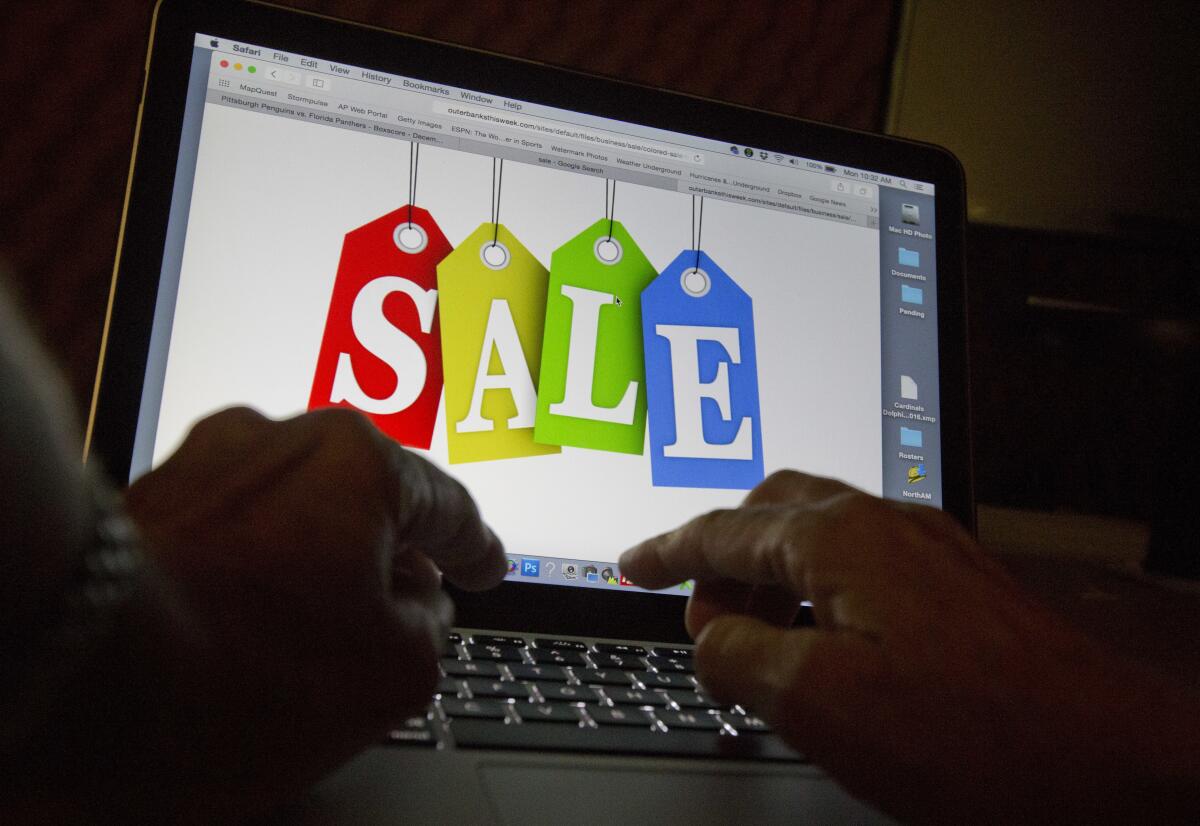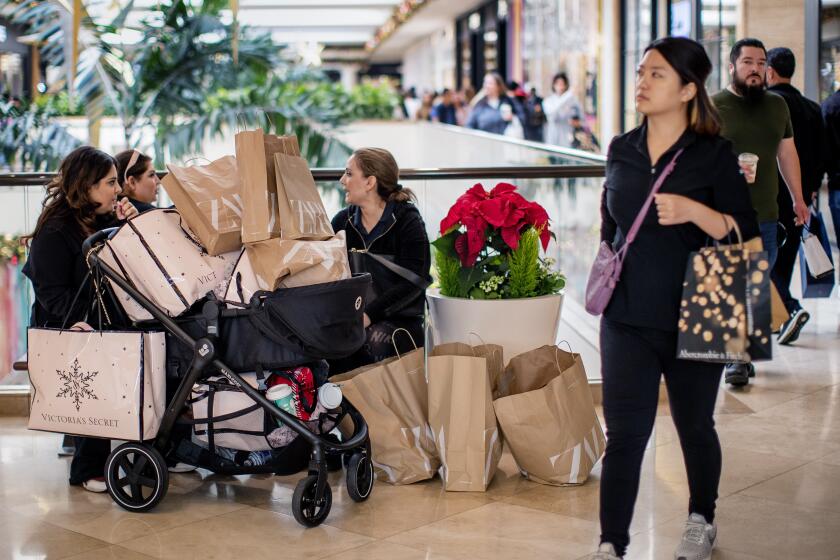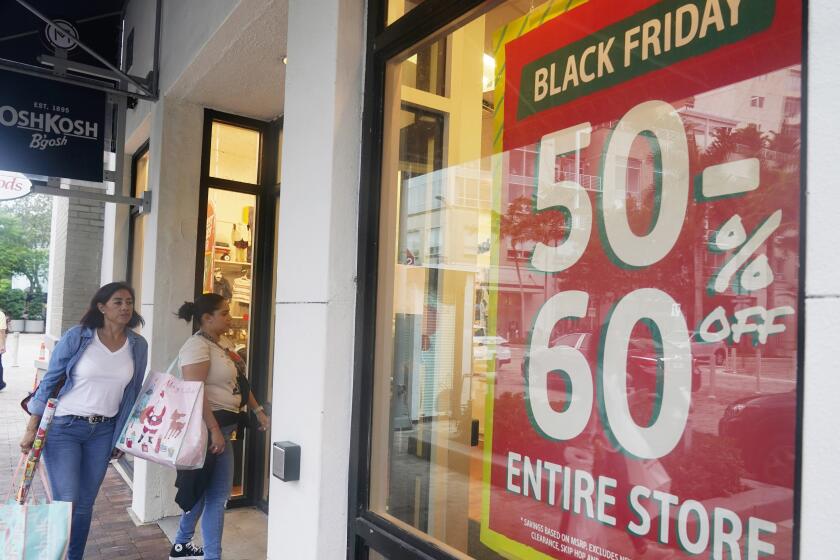Cyber Monday sales head for a record as deals lure inflation-battered consumers

- Share via
Days after flocking to stores on Black Friday, consumers turned their attention to Cyber Monday to score more discounts on gifts and other items that have ballooned in price because of high inflation.
Cyber Monday is expected to remain the year’s biggest online shopping day and see as much as $11.6 billion in sales, according to Adobe Analytics, which tracks transactions at more than 85 of the top 100 U.S. online stores. That forecast compares with the $10.7 billion that consumers spent last year.
Preliminary data released Monday by Adobe Analytics showed consumers spent $6.3 billion by 6 p.m. Eastern time. Adobe’s numbers are not adjusted for inflation, but the company says demand is growing even when inflation is factored in.
Some analysts have said that top-line numbers will be boosted by higher prices and that the volume of merchandise purchased could remain unchanged — or even fall — compared with prior years. Profit margins are also expected to be tight for retailers offering deeper discounts to attract budget-conscious consumers and clear out their bloated inventories.
Shoppers spent a record $9.12 billion online on Black Friday, up 2.3% from last year, according to Adobe. E-commerce activity continued to be strong over the weekend, with $9.55 billion in online sales.
Black Friday crowds were bigger this year. But overall holiday sales could be muted as inflation squeezes most consumers. Meanwhile, well-off shoppers are spending freely.
Salesforce, which also tracks spending, said its estimates showed online sales in the U.S. hit $15 billion on Friday and $17.2 billion over the weekend, with an average discount rate of 30% on products. Electronics, active wear, toys and health and beauty items were among those that provided a big boost, the two companies said.
Mastercard SpendingPulse, which tracks spending across all types of payments including cash and credit cards, said that overall sales on Black Friday rose 12% from a year earlier. Sales at physical stores rose 12%, while online sales were up 14%.
RetailNext, which captures sales and traffic via cameras, reported that store traffic rose 7% on Black Friday, while sales at physical stores improved 0.1% from the day after Thanksgiving last year. However, spending per customer dropped nearly 7% as cautious shoppers did more browsing than buying.
Another company that tracks store traffic — Sensormatic Solutions — said store traffic was up 2.9% on Black Friday compared with a year earlier.
“Shoppers are being more thoughtful, but they are going to more than a few retailers to be able to make a determination of what they are going to buy this year,” said Brian Field, Sensormatic’s global leader of retail consulting and analytics.
Shoppers seeking big deals — and relief from soaring inflation — may be disappointed as many items end up costing more than last year even after discounts.
Danny Groner, a 39-year-old who lives in New York City, said he and his wife want to get a new TV to replace one they’ve had for about seven years. He spent some time Monday searching for deals online and found some good discounts. Still, he says he wants to be intentional about what he buys and doesn’t mind spending a bit more for the right product.
Overall, online spending has remained resilient in the last few weeks as eager shoppers buy more items on credit and embrace “buy now, pay later” services that lack interest charges but carry late fees.
In the first three weeks of November, online sales were essentially flat compared with a year earlier, according to Adobe. It said the modest uptick shows that consumers have a strong appetite for holiday shopping despite uncertainty about the economy.
Still, some major retailers are feeling a shift. Target, Macy’s and Kohl’s said this month that they’ve seen a slowdown in consumer spending in the last few weeks. The exception was Walmart, which reported higher sales in its third quarter and raised its earnings outlook.
“We’re seeing that inflation is starting to really hit the wallet and that consumers are starting to amass more debt at this point,” said Guru Hariharan, chief executive of retail e-commerce management firm CommerceIQ, adding that there’s more pressure on consumers to purchase cheaper alternatives.
Toy giant Mattel is trying to confront the plastic pollution crisis with 33 playthings it says are sustainable.
This year’s Cyber Monday also comes amid a wider e-commerce slowdown affecting online retailers that saw a boom in sales during most of the COVID-19 pandemic. Consumers who feared leaving their homes and embraced e-commerce during the pandemic are heading back to physical stores in greater numbers this year as normality returns.
The National Retail Federation said its recent survey showed a 3% uptick in the number of Black Friday shoppers planning to go to stores. It expected 63.9 million consumers to shop online during Cyber Monday, compared with 77 million last year.
Amazon has seen its retail business thrive during most of the pandemic, but much of the demand waned as the worst of the pandemic eased.
To deal with the change, the company has been scaling back its warehouse expansion plans and is cutting costs by axing some of its projects. It’s also following in the steps of other tech companies and implementing mass layoffs in its corporate ranks. Amazon CEO Andy Jassy said the company will continue to cut jobs until early next year.
Shopify, a company that helps businesses set up e-commerce websites and also offers offline software, laid off 10% of its staff this summer.
The company said Monday that its merchants worldwide have surpassed $5.1 billion in global sales since the start of Black Friday in New Zealand. And spending per U.S. customer went up $5 compared with a year earlier, Shopify President Harley Finkelstein said.
Despite the bump, Finkelstein said shoppers were more intentional about their spending this year and were waiting for discounts before making a purchase.
More to Read
Inside the business of entertainment
The Wide Shot brings you news, analysis and insights on everything from streaming wars to production — and what it all means for the future.
You may occasionally receive promotional content from the Los Angeles Times.













